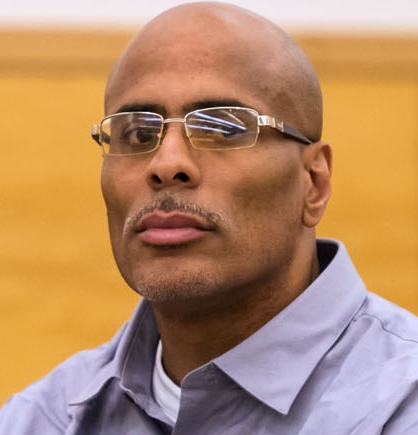 Shabaka Shakur Shortly after 10 p.m. on January 11, 1988, 21-year-old Fitzgerald Clarke and 23-year-old Steven Hewitt were fatally shot outside a building at Gates and Irving Avenues in Brooklyn, New York, where they sold narcotics.
Police brought in 23-year-old Louis Holmes for questioning the following day. Holmes—who later changed his name to Shabaka Shakur—was a friend of both victims, and a witness said that Shakur had quarreled over money he owed to Hewitt after buying Hewitt’s green Mercedes Benz.
Shakur was initially interviewed by police detective Phillip Mahony, who would later testify that Shakur denied shooting the victims and claimed he was in Jamaica, Queens at the time of the crime with his girlfriend.
However, Detective Louis Scarcella said that he subsequently questioned Shakur and that Shakur told him that the victims were drug dealers and were going to kill him, so he shot them first.
Another witness told police that Shakur—before he was arrested—had admitted committing the crime. That witness, however, was not called to testify at Shakur’s trial, and in 2014 recanted his statement, saying he had lied to police to try to obtain leniency on other charges pending against him at the time.
Shakur went to trial in Kings County Supreme Court in February 1989. Clarke’s brother, Harley Young, testified that he was in the building at the corner of Gates and Irving when he heard gunfire. He said he came outside and saw Hewitt on the ground. Young said he saw Shakur chase and then shoot Clarke before fleeing the scene. Young admitted on cross-examination that he first told police he did not see the shooting.
Young said that earlier in the day, Shakur had quarreled with the victims over the price of the car he was in the process of buying from Hewitt. Young said Shakur claimed the price was too high.
Scarcella testified that Shakur told him, “Man, you know I just got out. I spoke to the cops before on another case, and all it got me was jail. You know what happened. You have it all. They were going to kill me….They deserved to die. The two of them are part of an organization. They are drug dealers. The organization is bigger than you and me.” Scarcella admitted that he had no notes of the interrogation—only a report that he said he typed up after speaking with Shakur.
A gun found in a trash can near the scene was linked to the murders, but there were no finger prints or palm prints on the gun and it was not linked to Shakur.
Two women—Shakur’s girlfriend and the girlfriend’s best friend—told Shakur’s defense lawyer that Shakur arrived in Jamaica, Queens about 9 p.m.—an hour before the shooting—and spent the night in the girlfriend’s home before going to work the following morning.
On February 15, 1989, the jury convicted Shakur of two counts of second degree murder. He was sentenced to 20 years to life in prison.
In 2012, a motion was filed seeking a new trial for Shakur, claiming that a witness would testify that Young was inside the building at the time of the crime and could not have seen the shooting.
In 2013, the Brooklyn District Attorney’s Office began investigating about 70 murder cases connected to detective Scarcella. The investigation was triggered by the 2013 exoneration of David Ranta for a Brooklyn murder. A few months after Ranta was released, The New York Times published an article accusing Scarcella, who retired in 1999, of misconduct in many investigations: fabricating evidence, coercing witnesses and concealing evidence of defendants’ innocence. The article reported that one witness, Teresa Gomez, a crack addict, had somehow testified as an eyewitness in six separate murder cases.
Among the cases the Brooklyn District Attorney’s Conviction Review Unit agreed to review was Shakur’s, but in 2014 the prosecution concluded that the conviction was correct and that Shakur was guilty.
Later in 2014, Defense attorney Ron Kuby presented evidence that Scarcella had fabricated the confession at a series of hearings on Shakur’s motion for a new trial.
The women who would have testified at the trial about Shakur’s whereabouts at the time of the crime—one of whom he later married—testified at the hearings. The prosecution reported that witness who claimed Shakur had confessed had recanted. And another witness testified that she was with Harley Young—Clarke’s brother—when the shots were fired and that Young’s claim of seeing the shooting was false. Scarcella himself testified during the hearings and denied that he fabricated the confession.
On June 2, 2015, New York Supreme Court Justice Desmond Green granted the motion for a new trial and vacated Shakur’s conviction. Green ruled that there was “a reasonable probability that the alleged confession of (Shakur) was indeed fabricated.” The judge said that Scarcella’s version of obtaining the confession was “particularly troubling and causes serious doubts.” The judge also said he believed the testimony of the Shakur’s alibi witnesses.
On June 4, 2015, the charges against Shakur were dismissed at the request of Brooklyn District Attorney Kenneth Thompson, who said, “While Judge Green’s decision was not based on a finding of actual innocence, our ability to retry has been compromised by a number of factors, including the death of the main eyewitness. Therefore, I have decided not to prolong Mr. Shakur’s incarceration with a lengthy appeal or retrial and will consent to his release.”
In March 2016, Shakur filed a claim for compensation in the New York Court of Claims and settled it in 2017 for $5.5 million. In addition, he settled a claim against the City of New York for $3.6 million.
In July 2018, Shawn Williams became the 14th exoneration connected to Scarcella.
– Maurice Possley
|